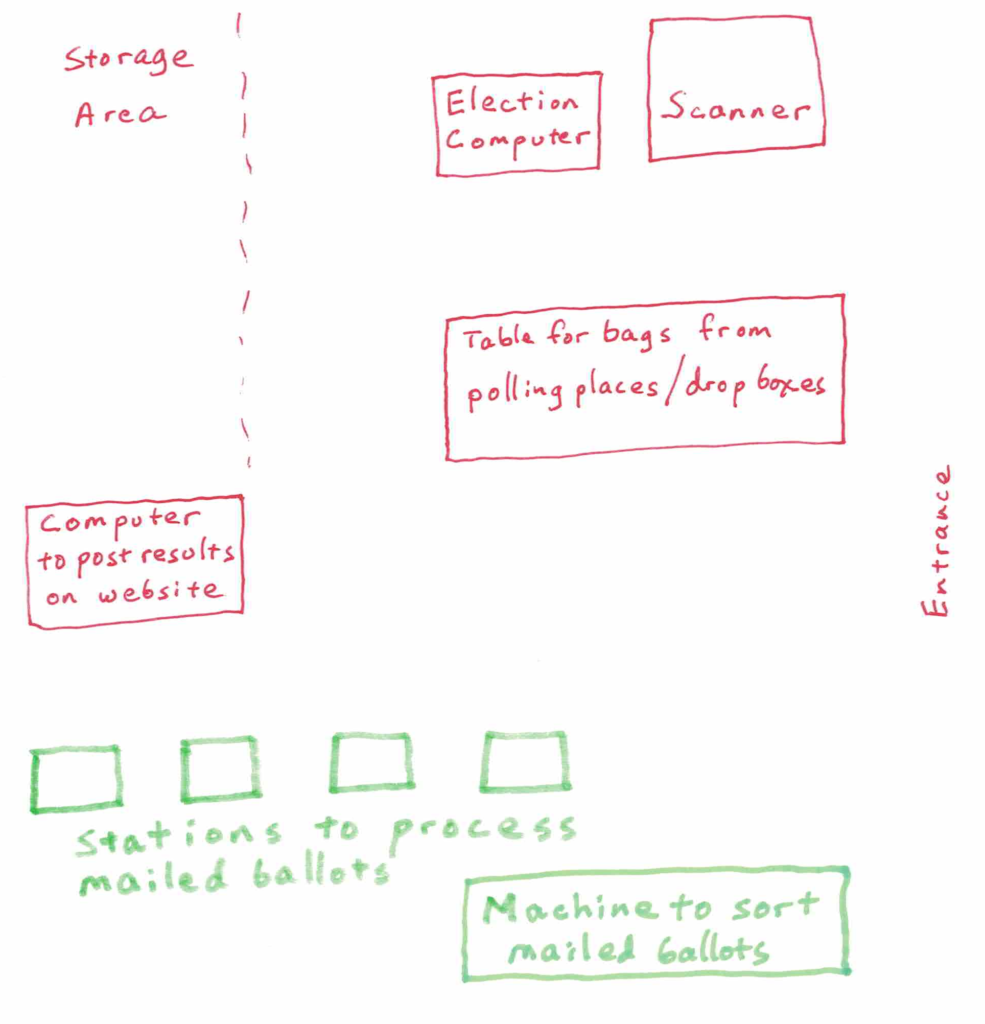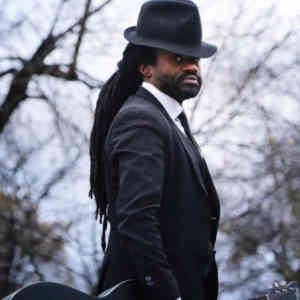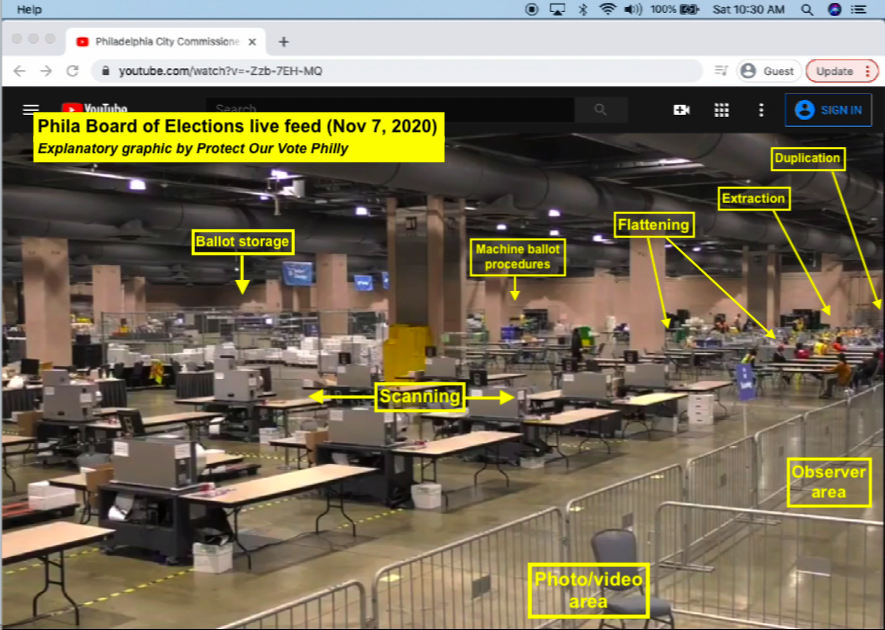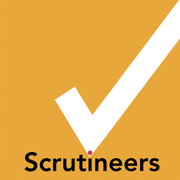We’re asking everyone who cares about fair elections — no matter who wins! — to prepare to observe AFTER the elections. Watch while your local election workers make sure every vote is counted accurately. Then let your community know how well it went!
Have you watched the introductory training yet?
If not, watch the intro training now before accessing other training materials.
Disclaimer: Scrutineers provides training materials for educational purposes only. You are responsible for assessing the safety of your environment and responding as needed. By continuing to use the material on this site, you agree to hold Scrutineers harmless for incidents you encounter while volunteering as an election observer.
Items below marked with ☀️ have been added or updated recently.
Essential Resources
We encourage you to review all the materials in this section, no matter when you’ll be observing.
Bring a notebook and/or several copies of this printable form. (You can use our online form if you’d prefer, but this isn’t ideal because you could lose reception or be prohibited from using a phone. If you want to use the online form, be sure to have the link handy.)
It’s important to write down your observations as soon as you can, before you forget details or get distracted by the next thing that happens.
Include details that will help others understand what happened and who was involved. Here’s a “Goldilocks Guide”:
| Not enough detail | JUST RIGHT | Too much detail |
| I went on Wednesday and watched some people from the election office working on vote by mail processing. It didn’t seem like they were being very careful. | 11/9/22 at 3:20 PM. A 40-ish white man wearing a plaid shirt, with short dark hair and glasses, said he worked for the election office. He was sorting envelopes into three piles. He took one pile and walked away, leaving the other piles on a table with no one watching them. I told Wanda, the supervisor. | 11/9/22 at 3:10 PM. I don’t know the name of this guy, but he was maybe around 40, a pale white man wearing a red, blue, and green plaid shirt, with short dark hair and tortoise-shell glasses, said he worked for the election office. I saw him sorting envelopes into three piles on a large table. He picked up the tallest pile in his left hand and walked down a hallway where I couldn’t see him, leaving the other piles on a table with no one watching them. I told Wanda, the supervisor, a short Black woman wearing a tan suit. |
Sketching the layout of the room will help you remember & track who went where. You can do this on the back of the notes form. Here’s an example:

Before reporting to anyone:
In deciding what else to tell, consider the following:
- Who was involved in the error or situation?
- Must action be taken immediately to correct the mistake?
- Who do you believe has the power to act?
- Is outside intervention needed?
Options for Reporting Issues
- Staff member designated to answer observer questions. If necessary, ask to speak with a supervisor.
- Your buddy & other observers in the room
- SeeSay2022.com [site not live yet]
- State election groups
- Candidates
- You may know some contacts. Find more at: https://ballotpedia.org/Sample_Ballot_Lookup
- Lawyers at 866-OUR-VOTE, and/or other lawyers:
- English: 866-OUR-VOTE – Lawyers’ Committee for Civil Rights Under Law
- Spanish/English: 888-VE-Y-VOTA – NALEO Educational Fund
- Arabic/English: 844-YALLA-US – Arab American Institute (AAI)
- Asian Languages/English: 888-API-VOTE – APIAVote & Asian Americans Advancing Justice (AAJC)
- Voter protection field programs: legal – managed by the Lawyers’ Committee for Civil Rights Under Law and grassroots managed by Common Cause
- Digital outreach tools: including 866ourvote.org, @866ourVote, and facebook.com/866OurVote
- US Department of Justice (DOJ)
- Every part of the country has a US Attorney. Each one names an election lawyer who can investigate federal issues. Change ohio to your state at end of this search: https://duckduckgo.com/?q=%22district+election+officer%22+ohio
- The head office of the Justice Dept (DOJ) monitors some areas, and you can send them reasons to monitor other areas as well. 202-307-2767 or 800-253-3931
- DOJ also receives complaints about civil rights discrimination.
- Election Official Legal Defense Network
- They have lawyers who defend election staff against punitive enforcement of state laws (not against public or observers)
- Scrutineers may be able to help guide you toward appropriate action. Reach us on Twitter @ScrutineersUS or email us.
You may have heard stories of a person’s right to vote being challenged, that the person is too young, lives somewhere else, etc. This happens at the polling place.
Challenges also occur during post-election observation. A challenger looking at the name, address and signature on the outside of a vote-by-mail envelope can question whether the votes inside should be counted. Election staff then have to decide whether to:
- agree with the challenge and set aside the unopened envelope, or
- reject the challenge and open the envelope to count the votes inside.
A similar process happens with provisional ballots, which are ballots used when the eligibility of a voter cannot be determined at the polling place.
Some challenges are legitimate, while others are malicious and intended to prevent a vote from being counted. Or even worse, to challenge (and stop) as many votes as possible.
In contrast, your role as an observer is to witness, learn from, and improve the electoral process.
There are also election monitors, who are generally appointed to observe and to assess that an election is in compliance with the federal voting rights laws.
There’s some variation from state to state in how these terms are used.
Locks, Seals, & Security Cameras are all part of the election office’s work to keep voting materials safe from tampering. How these are handled is important, yet none of these security methods is perfect. Still, we deserve to know how well security systems are set up. As an observer, you can look for indications of how careful officials and staff are being about security of ballots and other sensitive materials.
Election workers and other observers may be suspicious if you take a close interest in election locks and seals. You’d be suspicious yourself if someone wanted details about locks on your home!
A few things to keep in mind:
SEALS are generally designed to discourage unauthorized people from opening containers of ballots, etc., rather than to physically prevent access to the contents. You may hear the phrase “tamper evident seals.” These are seals that are designed to make it obvious when they’ve been removed/replaced.
Security seals used in election offices should be numbered, with a log kept of all the numbers. Before opening a sealed container, the number should be checked against the log. This is an important process to observe, as it’s part of documenting that the chain of custody of the ballots or other materials has been securely maintained.
Other things you can look for:
LOCKS: Who has the keys? Where are they kept? Are locks actually locked when they should be?
SECURITY CAMERAS: Are they working? Are they well-positioned to film what’s going on? Is anyone monitoring the video?
CAMERAS for REMOTE MONITORING: If you’re planning to observe remotely via video feed, we strongly recommend that you ask for details in advance about the camera set-up. Cameras configured for security are very unlikely to give you views of the action clear enough for meaningful observation. Ideally, remote monitoring video cameras should be set up to enable you to see the workers and the print on the papers or computer monitors involved in each task.
Want to know more about locks, seals, and security cameras? Delve as deeply as you’d like into the topic on Scrutineers member Paul Burke’s website: http://www.votewell.net/locks.html.
The same people who pushed The Big Lie about the 2020 election are threatening to disrupt the midterms as well. We anticipate that they’ll show up both to try to stop people from voting and — in the days following the election — to try to stop the vote counting. Observing vote processing and counting has historically been a safe volunteer activity. Unfortunately, it’s possible that won’t be true this year. While we can’t prepare for every possible situation you’ll see, we’d like you to feel confident in the face of the most likely situations.
We brought in two trainers with expertise in nonviolent conflict response to produce a special training session, conducted July 31, 2022). All the materials from that training are provided for you below.
Recorded Training Session (5 short videos):
Intro and Context:
Kristine’s Presentation on Conflict Resolution:
Rev. Sekou’s Presentation on Nonviolence:
Tactical Training:
Kristine’s Breakout Group (skills demonstration):
Conclusion:
Handouts
Supplementary Interview:
Scrutineers Executive Director Emily Levy interviewed Rev. Sekou briefly to fill in some gaps in the training. This 20-minute discussion includes:
- How to assess the danger level before you go
- Whether and when to call law enforcement
- How to find the courage to take risks
- … and more
Note: The video quality improves after the first 30 seconds.
About the Trainers:

Rev. Osagyefo Sekou
With the Deep Abiding Love Project, Rev. Osagyefo Sekou has helped trained over ten thousand clergy and activists in militant nonviolent civil disobedience through the United States. He spent 6 weeks on the ground in Charlottesville, VA training clergy in response to the Unite the Right rally.
A leading public intellectual, Rev. Sekou written two collection of essays. Urbansouls: Meditations on Youth, Hip Hop, and Religion and Gods, Gays, and Guns: Essays on Religion and the Future of Democracy. He has written widely on the 2011 killing of Mark Duggan by British police and the subsequent London riots, and is the author of the forthcoming Riot Music: Race, Hip Hop and the Meaning of the London Riots 2011 (Hamilton Books).

Kristine Scott
In 2008, Kristine took an AmeriCorps job running a meal program for unhoused young people. Almost 50 hungry youth arrived on Kristine’s first night. What happened next was terrifying for a young, small town white woman. Her purse went missing, there were fights and screaming guests. Kristine vowed to never return. But then something unexpected happened. A 17-year-old guest instantly turned the chaos into quiet, polite behavior with a single phrase. This began Kristine’s journey of learning from those she served, people living in constant threat and conflict. Through their mentoring and hundreds of incidents, she began to see conflict as a place to deepen a connection and counter social inequity.
Kristine has since trained thousands of people how to respond not react, lean in and not lash out. She particularly enjoys working with women who are naturally skilled at de-escalation after they debunk the false narratives around gender roles. In her free time, she hangs out with her backyard ducks and sculpts scrap metal.
☐ Directions to the observing location
☐ Mask (safer and often required)
☐ Photo ID (if required)
☐ Phone and/or video camera (Note: Empty your storage so you have plenty of room on your device.)
☐ Extra battery/charger for your phone or other video device.
Optional:
☐ A measuring tape app if you have to keep a certain distance from workers
☐ Binoculars (You may be far from the action).
☐ Water and snacks (choose something quiet and not messy or sticky)
☐ A few pens, preferably not blue or black, so no one can blame you for stray marks on election materials
☐ Notebook and/or one of the forms provided in the section above called “Instructions for Documenting What You See.”
If your time is tight or you’re only available certain hours, we encourage you to observe when you can, no matter what is going on at that time.
If you have more time or more flexible time, you can refer to this list of some of the highest priority processes to observe. (Note that many processes will happen simultaneously, as shown in this photo.)

One thing to consider when you decide what to observe is whether or not you’re able to get close enough for meaningful observation. If you’re kept behind a barrier (as illustrated in the photo), the general flow of ballots around the room may be all you can observe. If you’re permitted to be closer, you’ll have more options.
Observing the chain of custody of election materials is always important. This could include watching the arrival of ballots and election materials, noting whether or not anyone is alone with ballots, computers, or thumb drives, and checking on locks and seals.
If you see breaks in the secure chain of custody:
- Take careful notes
- Talk with election official
- Report it to the 866-OUR-VOTE hotline
- Consider talking to the press or candidates’ representatives
Highest priorities:
When to observe:
1. The first hour after polls close on election night. You should see workers posting initial vote totals to the internet. Note whether thumb drives are being re-used (refer to our introductory training for an explanation of this issue).
2. Later election night. It’s likely the vote processing center will stay open very late.
3. Any day, especially at the end of the day, to see how they lock things up at the end of work.
What to observe (see additional training materials for these processes):
- Auditing
- Review of provisional ballots
- Ballot duplication
- Ballot curing
- Signature verification
- Adjudication
Training Materials for Specific Election Processes
Watch how ballots, and in some cases, poll tapes, and digital media arrive at the central counting location for scanning and tabulation. Note measures taken routinely to ensure security of the paper ballots (chain of custody), such as two poll workers traveling together when returning the ballots from a voting location. Refer to our introductory training for more specifics.
When voters vote at home and deliver their ballots by mail, by dropbox, or in some places by bringing their ballot into an election facility, the ballots are contained inside an outer envelope. The outer envelope has on it the voter’s name, address, and signature. A determination is made about whether or not the ballot inside will be counted before the envelope is opened.
Immediately when the envelope is opened, it is separated from the ballot itself to protect voter privacy.
In some places, there is also a privacy sleeve or envelope inside the outer envelope.
The local procedures to determine whether or not an absentee or mail ballot should be counted must be followed carefully. These procedures generally include determining whether or not the signature on the outer envelope matches the voter signature on file. (See separate training section about signature authentication.)
This video from the Registrar of Voters in Orange County, California discusses the processing of mail-in ballots, how signatures are authenticated, and related issues. Note that different processes are happening at different stations around the room at the same time.
What to Look For, Notice, and Document:
- Are envelopes with identifying information separated from the ballots within before anyone looks at the ballots?
- Are rules about deadlines for arrival of absentee/mail ballots being followed? (In some places, for example, ballots must arrive by election night, while in other places, a postmark on or before election day is sufficient.)
- When signature is missing from envelope or cannot be authenticated, are voter contacted? (This process is called “ballot curing.” It is not required in all states. Check your state’s requirements.)
Note: In some places, absentee/mail ballots are batched by precinct, combined with ballots voted at polling places and at early voting sites. If you plan to do any comparisons of vote totals, it’s important to note whether or not batches include all these types of ballots. Otherwise, you may be comparing apples to oranges.
Both mail ballots and provisional ballots arrive at the processsing facility inside envelopes signed by the voter. Before opening each envelope and removing the ballot, election staff must determine whether the requirements have been met for having the votes inside counted. This can include checking tracking numbers and verifying the voter’s signature on envelopes such as the one in this example from the Center for Civic Design.

It’s important to observe the way the movement of these materials is tracked, ensuring that no batches are missed.
Eighteen states require checking that a signature be present on the ballot envelope, but don’t check what it looks like unless an investigation happens for some reason.
An article about this process is behind a paywall, but its map, with gray states where no signature matching is done, is freely accessible.
The other 32 states and Washington DC quickly compare the envelope signature to signatures on file, from voter registration, drivers’ licenses and/or other government documents. Election observers may not be able to see mailed signatures closely enough to see how well the process happens, and if they disagree with staff decisions, they may or may not have a way to get improvements. Access may be better in smaller communities.
If you think you’ll be able to get close enough for meaningful observation of the process, watch our in-depth training on signature authentication by national expert Sheila Lowe.
Machines can make mistakes, so audits are necessary to verify vote counts. Truly robust audits would also include checks on procedures as well as counts, but these are not routinely done. Even vote counts are not checked thoroughly. Audit requirements vary by state.
Check this table of state-by-state audit rules to find the requirements in your state. You’ll find other useful information about audits at this link as well.
It’s very important to observe any audits that are done in your local election. The following material is about random selection audits, which are by far the most common. In a random selection audit, a portion of the ballots are chosen at random and then either counted by hand (preferred) or run through the scanners again, looking to see if the new count matches the original count. For the audits to be meaningful, the procedures must be airtight and must be followed precisely.
These are the most important parts of the audit to observe:
- Random Selection
- Pulling of batches of ballots from storage
- Tallying the votes, making sure results are not changed based on problems found
Why can’t they just correct the sample if problems occur?
Ray Lutz of Citizens’ Oversight explains this tricky concept with an analogy: Let’s say you worked in a television factory. It’s your job to see if the production line is working properly by sampling 1% of the TVs. So you take 1% of the TVs off the conveyor belt, plug them in, and turn them on. You find that some of them don’t work. If you fix those broken TVs, does that mean that all of the TVs on the production line have been fixed? No, it means there are likely a lot more TVs on the production line that are also broken. Similarly, with election audits, if the recounted votes in the randomly selected batches don’t match the original counts, it means more action must be taken to determine the true vote counts. Cleaning up the totals of the selected batches only hides the problem.
Election officials create new ballots from voted ballots that could not be scanned. These could be damaged ballots that failed to scan, or Federal Write-in Absentee Ballots (FWAB)* that are in the wrong format. Different places call these recreated, reconstructed, remade, or duplicated ballots.
Here’s a brief video from the Michigan Bureau of Elections showing how ballot duplication is to be done in Michigan. Details may be different in your location, but the concept remains the same.
Note and take action if you observe any of these flaws:
- Only one person is re-creating ballots. There should be at least two people so each can read the original ballot and each can observe the marking of the new ballot.
- Re-creation team not checking each other. The person reading the original ballot doesn’t check the work of the person marking the new ballot, and visa-versa.
- No accounting linking original with new ballot. A pairing should be made, such as writing a number on each re-created ballot and its original ballot, so the new ballot can be verified later.
- Paper flow lets a ballot be copied more than once (by hand or mechanically).
- Workers use white-out instead of or in addition to ballot duplication, or mark original ballots with a pen.
Consider this:
- Ask whether damaged ballots can be photocopied onto paper of the correct size & weight for scanning instead of being hand-copied.
*The FWAB is a minimal ballot for people abroad (and military in the US) who don’t get a real ballot in time to vote it. More info: https://www.fvap.gov/election-materials
Verify Vote Counts Using Poll Tapes
Are you available on election night after polls close?
Another effective way to provide public oversight is to capture the original vote counts, printed on “poll tapes” that look like cash register receipts. You can do this with your cell phone’s video camera. Vote totals on the poll tapes can be compared with official vote counts produced later, to make sure the count hasn’t changed.
Read more about poll tapes at https://scrutineers.org/get-involved/poll-tapes/
Links from the chat during the training:
Actual Vote app: americacounts.us/actual-vote-portal
State-by-state information on posting poll tapes: https://americacounts.us/actual-vote-state-select/
Poll tape videos from previous elections: https://av.democracycounts.org
Transparent Elections NC’s poll tapes project: https://www.transparentelectionsnc.org/poll-tape-project-nc (training and additional resources)
Find Scrutineers on Twitter: http://twitter.com/ScrutineersUS
Find America Counts on Twitter: https://twitter.com/america_counts
America Counts YouTube channel: https://www.youtube.com/channel/UCLbgLbclL44MYP-cxzKtxHw
A Few More Things…
Join the Scrutineers Community!
It’s a great place to learn more, connect with others, and take additional actions in the struggle for fair, transparent, accessible, and secure elections! Learn more
Let us know if you have any questions.
Contact us by email.
Get Notified
Complete the form below (if you haven’t already) to be notified of updates to this page including new training materials. We’ll also email you about future live training sessions.
Get More Resources & Updates
"*" indicates required fields
